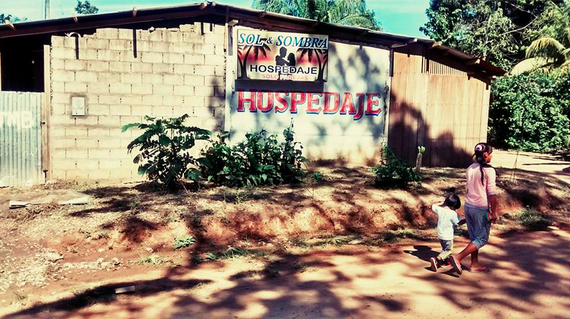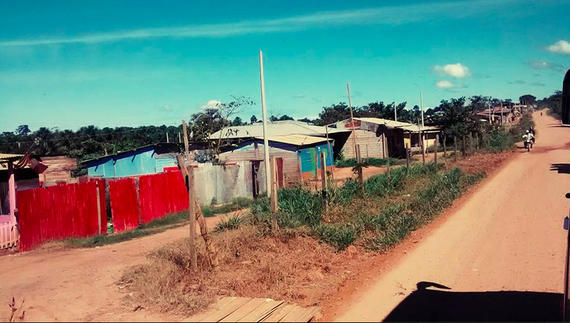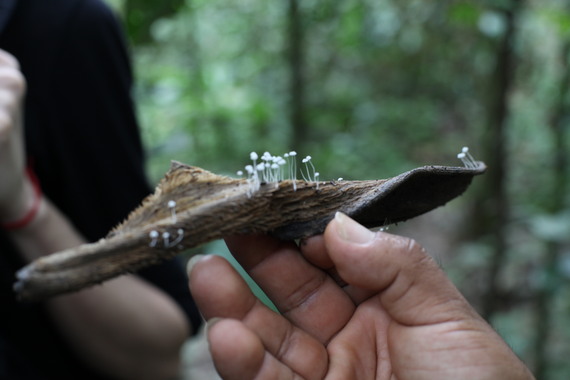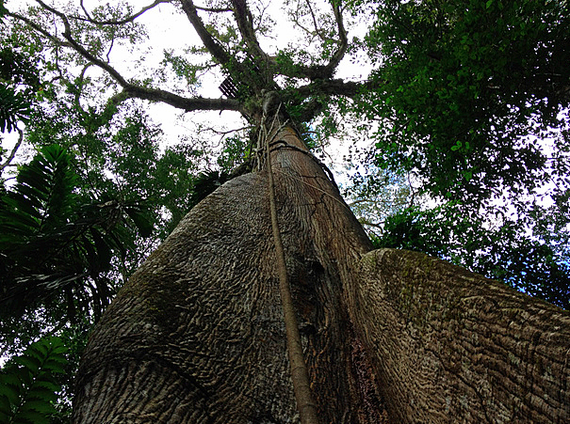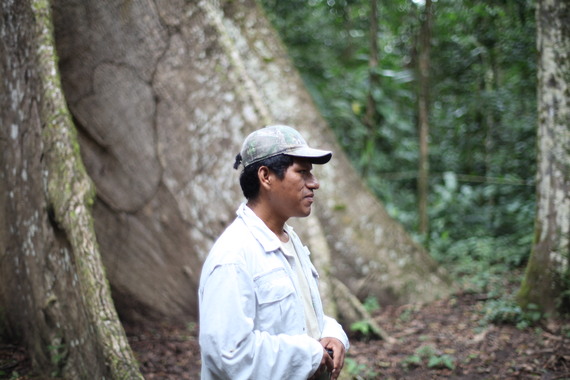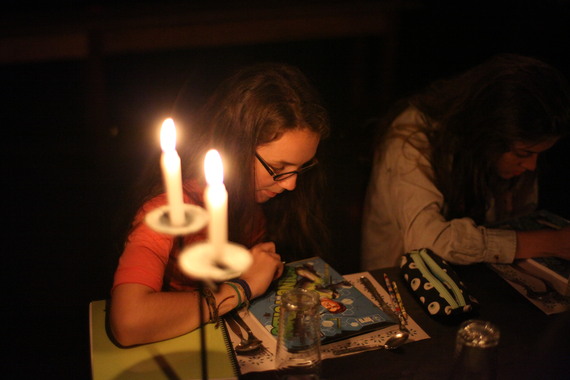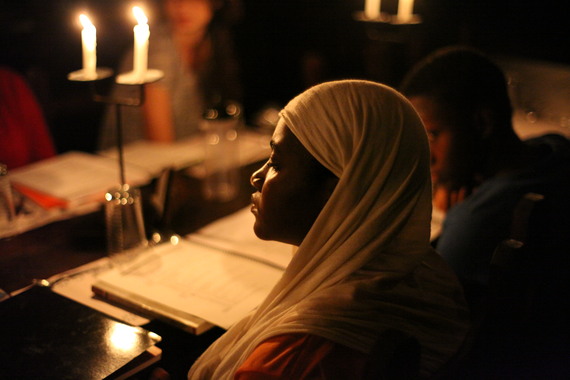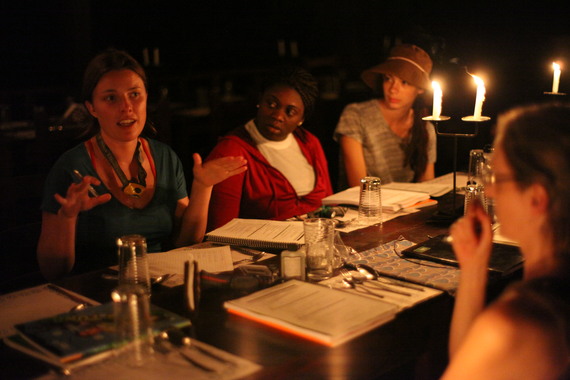Day 3 of the 2015 Advice Project Leadership and Empowerment Summit for Teen Girls and Women in Peru (Gold Mining, Sex Trafficking, Sacred Trees and Conservation, and "The Advice Project Summit Challenge")
Waking up at the crack of dawn with a group of twelve teens and women isn't an easy task, but we had a flight to catch from Lima to Puerto Maldonado, so it couldn't be helped. Advice Project filmmaker, Courtney Webster, whipped up some breakfast sandwiches for the group at 4:30AM, and we miraculously, albeit with foggy eyes, left our hostel for the airport by 5:15.
Our flight to the rainforest took us over the Andes Mountains, which drew a jagged line towards the horizon both north and south. As we looked out of the window towards the glacier-covered peaks in the distance, excitement over what the next two weeks at the Advice Project Leadership and Empowerment Summit might hold started to build. Or maybe we were just waking up from the coffee many of us had gulped down.
Soon, the mountains flattened into verdant emerald jungle for as far as the eye could see. Imagine the biggest forest you've seen. Multiply it by ten... by one hundred... It is a breathtaking sight. An important sight.
For some of us, it was also horrifying. We got our first glimpse at huge swaths forest that had been completely denuded due to gold mining. Only poisoned, lifeless deserts and large pools of mercury-filled yellow water remained. These were some of the places Tom Bewick (Program Manager of The Rainforest Foundation - US) had told us about the night before at our first summit dinner.
We had, of course, believed Tom, but hearing the facts and then seeing them are two different things. We knew about climate change and the decimation of the rainforest, but seeing it unfold from 20,000 feet as below us the shadow of our plane flitted between forest and desert gave the issues a new, urgent sense of gravitas.
The rainforest in the Amazon River Basin provides the breath of our planet. It is our responsibility to ensure that the suffocating hands placed around it by various corporations, governments, and apathy, are released so that subsequent generations of humans and countless species of life can survive. Learning how we, as teens and women, could partner solutions to this problem, would be one of the goals of the next two weeks.
Stepping out onto the tarmac of the Puerto Maldonado airport, our senses were bombarded by bright yellow light, the heat of the sun, and the thick, humid smells of the nearby forest. We breathed deeply: a year and a half after many of us had committed to this trip, and finally, we had arrived to the rainforest - la selva.
Our guide from the Inotawa Expeditions Ecolodge, Jaime, met us in the waiting room of the airport; after introductions, he ushered us towards the bus that would take us through the town of Puerto Maldonado and then onward down a long, muddy, bumpy road towards the Tambopata River, a tributary of the mighty Madre de Dios River, on which people make their living via gold mining, mango farming, and selective logging.
We passed a shantytown consisting of hundreds - if not thousands - of ramshackle family abodes, businesses such as auto mechanics, welders, cobblers, and small food markets, and a number of prosti-bars, which is where the men of the community head after long, dusty days of mining or farming to drink and hire prostitutes.
Most often, the prostitutes in Madre de Dios aren't prostitutes at all, but rather, sexually trafficked minors and young women lured to the district by promises of sewing jobs or childcare positions. These trafficked women arrive from mountain cities with few economic opportunities such as poor, rural communities outside of Puno and Cusco. Upon arrival, they are immediately indebted, which means they aren't allowed to leave until they "work off" the price their new "employers" paid to get them to the jungle.
Just as these women would've done had they been given sewing or childcare jobs, they receive meager - but meaningful - wages to send home to their families. Yet because they feel too much shame to tell their loved ones about the full reality of their new situations, most of them stay silent and work for one, two, three years before either trying to make an escape or until they finally are able to pay their "debt" to their employers or "age out" of their new "profession." Many girls who escape are subsequently punished by local police or forced to sign declarations absolving their traffickers.
Sexual trafficking isn't unusual. At least 20.9 million adults and children worldwide are bought, sold, or forced into sexual labor worldwide. Tens of thousands of these people are trafficked inside of Peru, and just as in the rest of the world, 98% of them are women and girls.
The shantytown we passed is not unusual. They crop up in increasing numbers throughout the Madre de Dios district and along the new Interoceanic Highway as waves of hopeful gold miners and trafficked girls head to the region, and Puerto Maldonado has doubled its population over the last five years. Miners are not bad people, but simply, are desperate for jobs that pay a living wage. The reality is simply that mining pays better than working many other jobs.
Advice Project Founder, Melissa Banigan, noted that when she last visited the region three years ago, the shantytown they passed was much smaller. Squatters had taken over plots of land and together, they had built a community, but without luxuries such as government schools, utilities, water purification, or health services.
The Peruvian government occasionally forms 'brute squads' to break up shantytowns, and it had done this recently to a few shantytowns in Madre de Dios, but these efforts make little difference, as squatters simply disband and then move their few belongings to new communities. It was sobering for us to see this shantytown up close, especially as we saw groups of school-aged children along the road who clearly weren't in school.
Our bus drove past the shantytown, over thin concrete bridges that hadn't been there even three years earlier, and on towards Infierno - or Hell. Infierno is a community of Ese'Eja native people, mestizos, and Andean colonists who have been allowed a land concession of 2,000 hectacres by the Peruvian government for reasons of future subsistence, ecotourism, and conservation. It was from a small boat port in Infierno that we left for the Inotawa, which was located in the buffer zone outside of the protected Tambopata Reserve.
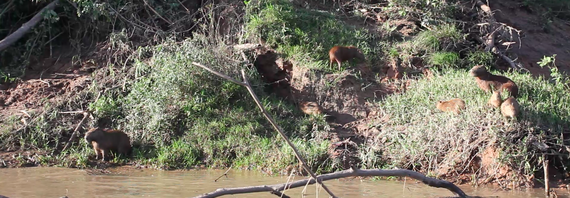
'Capybara family on the Tambopata River', ©AdviceProject, photo still from a video by Courtney Webster
Heading up river in a thin, single-motor boat, the girls and women went quiet as they looked out over the banks. Along the way, we listened to a cacophony of birds. On the banks, the girth of the trees grew wider; their height, higher. We saw a white caiman basking on the bank, but more exciting was the family of capybaras munching on grass next to the side of the river. The largest rodents on the planet, they look like giant guinea pigs, and seeing them, it became possible to envision other large mammals such as giant anteaters and giant tapirs.
We were greeted at Inotawa by Eva, the manager of the ecolodge, and once we were settled, we regrouped with Jaime for our first hike through the forest. Different species of parrots flew overhead (including red macaws!), and both bullet and fire ants, mushrooms, and a variety of insect species covered every tree we passed. Capuchin monkeys manically ate above our heads, and small saddleback tamarinds performed aerobatics as they leaped between the trees. The forest was abuzz with life.
Jaime led us to a giant ceiba tree (in the kapok family), about 45 meters high. He told us about how these trees had been stripped from the forest from the time of the rubber boom in the 1800s onward, and how their wood was used to make particle board and pulp. This gives a new perspective to purchasing cheap furniture from places such as IKEA, doesn't it?
This particular ceiba tree, Jaime explained, was special because it had escaped the axes of loggers. Revered by locals, it contained a spirit - a sort of god-like trickster like Loki or the anthropomorphic coyote - who protects the forest by playing games with people who wander close by at night. A small man with one stag leg and one leg of a young boy, the people he encounters will often vomit, shake, and turn pale. Jaime told us about encounters between the small spirit-man and visitors to Inotawa, and it was clear that he believed the stories.
Although it might've been easy for us to doubt Jaime's story, a more interesting approach is to think about how the trickster trope prevails both in both local, animist folklore, and also globally, on all inhabited continents, and throughout many cultures. The coyote, Puck, Loki, Anansi, the fox, and even Robin Hood, all have something in common with the ceiba spirit, and believe-it-or-not, we were lucky to learn about this Amazon River Basin variation of the 'trickster' from Jaime.
Listening carefully to Jaime and respecting the folk-story he shared with us drives home why we need to work to protect the rainforest. A single tree such as a giant ceiba is a physical symbol of many of the intangible things a culture holds dear. When it is cut down, then its story unravels and fades into the past. In the rainforest, folk stories are important and are also arguably vital - they help us remember our connection to the trees. This particular ceiba - one of the last great, ancient ceibas in the immediate area - ought to matter to people from around the world, whether they live in indigenous communities or on the far side of the planet. It is a symbol of what we need to preserve - both culturally and physically. I hope that we all might - at least symbolically - become believers in the small spirit-man that protects the forest.
This evening, back at the lodge, we ate a delicious meal by candlelight, and then talked about the next two weeks. The main purpose of the trip - to empower girls and women by giving them tools so that they could fashion and then share stories through media, writing, and film - was made evident when Melissa shared details about group projects:
"You'll work in small groups and you'll have two weeks," she said, "to identify global problems affecting girls and women, and then partner these problems with solutions. Together, your small group will need to either write an article or make a short film, and at the end of two weeks, you'll need to share your findings with the entire group."
Melissa told the group that it was up to each small group to come up with global problems that affected them at a gut level. Issues should pertain to illuminating gender inequalities, gender in the rainforest, conservation, or a combination of all three of these ideas.
Melissa provided books for each participant filled with readings to help get people started, and said that these materials would also serve to frame some of the important gender and conservation issues that would be brought up during daily discussions during the summit. She said that some of the material would be brand new, and that they might make people challenge their ideas about feminism and might even make them feel uncomfortable because of the various ideas we've been taught in our different cultures, churches, schools, or communities. Some of the topics, she said, might even be considered "taboo" for some of us.
"Discomfort is OK," Melissa explained. "We don't have to like everything, and we don't have to agree with all of the ideas presented. We do each need to listen and respect the fact that each of us is unique and will come to the table with different views, backgrounds, and identities." She urged people to ask difficult questions rather than holding them in, because only by asking them could we then start to examine both differences and similarities.
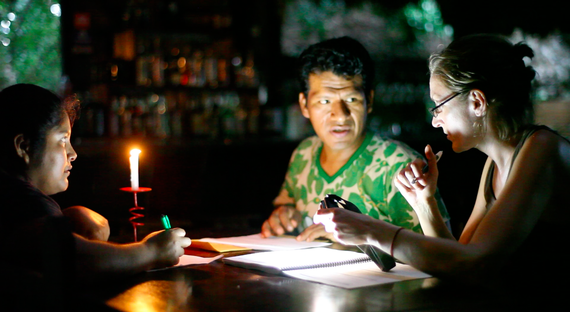
'Eva, Jaime, and Melissa strategizing for the next two weeks', ©AdviceProject, photo by Courtney Webster
"We each came to the rainforest," Melissa continued, "for different purposes. Some of us came to learn about the animals and trees. Others came because they wanted to tackle different global gender issues. All of these reasons are OK as long as we each participate with open minds and hearts and remember that we're here not only to see the rainforest, but to report back to our communities about what we see."
Tonight we will fall asleep beneath the romantic, gauzy cotton canopies that cover our beds and keep out insects. Candles are aglow, and above us, oil lamps flicker within shallow recesses in the walls. Some of us are still jet-lagged from long international travels, and all of us are exhausted from our early morning flight. Unfortunately, five of us are also dealing with an intestinal bug that is causing discomfort and low-grade fevers. We expect this to pass in a day or two, but in the meantime, we're carefully monitoring the people who are suffering.
A soft rain starts to fall, and one by one, the oil lamps and candles are blown out. Darkness descends, and a new, exciting day in the rainforest awaits.
______________________________________________________
This post is part of an ongoing series on The Advice Project about the 2015 Advice Project Leadership and Empowerment Summit in Peru. It was originally posted on The Advice Project by Melissa Banigan. Click here to learn how you can bring The Advice Project's workshops to your community.



